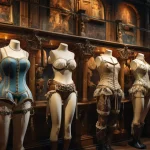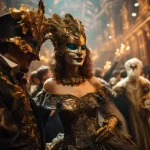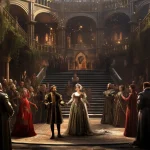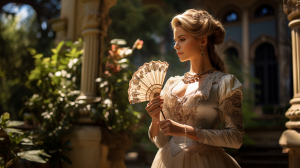
The Gateway to Grandeur: Unveiling the Mystique of Baroque Fashion
Ah, the allure of Baroque fashion, a world so opulent, so extravagant that it leaves an indelible mark on the canvas of history. Picture this: sumptuous velvets and silks flowing with an ease only matched by their elegance, intricate embellishments that seem to dance under the candlelight, and striking silhouettes that command attention in every room. Yes, dear reader, the world of Baroque fashion is indeed a sumptuous feast for the senses, a labyrinth of excess and grandiosity that continues to captivate us to this day. 🌟
In this fashion odyssey, we will traverse the corridors of time, venturing deep into a bygone era that continues to resonate in the folds and frills of contemporary style. The Baroque era, a period spanning from the 17th to the early 18th century, is not merely a point in history; it is a vivid tapestry that interweaves art, culture, and societal values—a tapestry where fashion serves as a compelling narrator.
From the golden palaces of Versailles to the intricate tapestries adorning the halls of grand estates, Baroque fashion was a tangible expression of the era’s grandiosity. It wasn’t simply about cloth and thread; it was a declaration, a form of visual rhetoric that articulated the beliefs, power dynamics, and cultural underpinnings of a vibrant historical period.
As we embark on this sartorial journey, you will find each tapestry thread unraveling to reveal fascinating stories behind clothing choices, fabrics, and accessories that defined this era. Prepare to be mesmerized by a world so abundant in splendor that it teeters on the edge of fantasy and reality.
So, fasten the laces on your corsets, adjust the feathers in your intricately designed hats, and get ready to step back in time. For those with an insatiable curiosity and an appreciation for the finer details, you’re in for an exquisite treat.
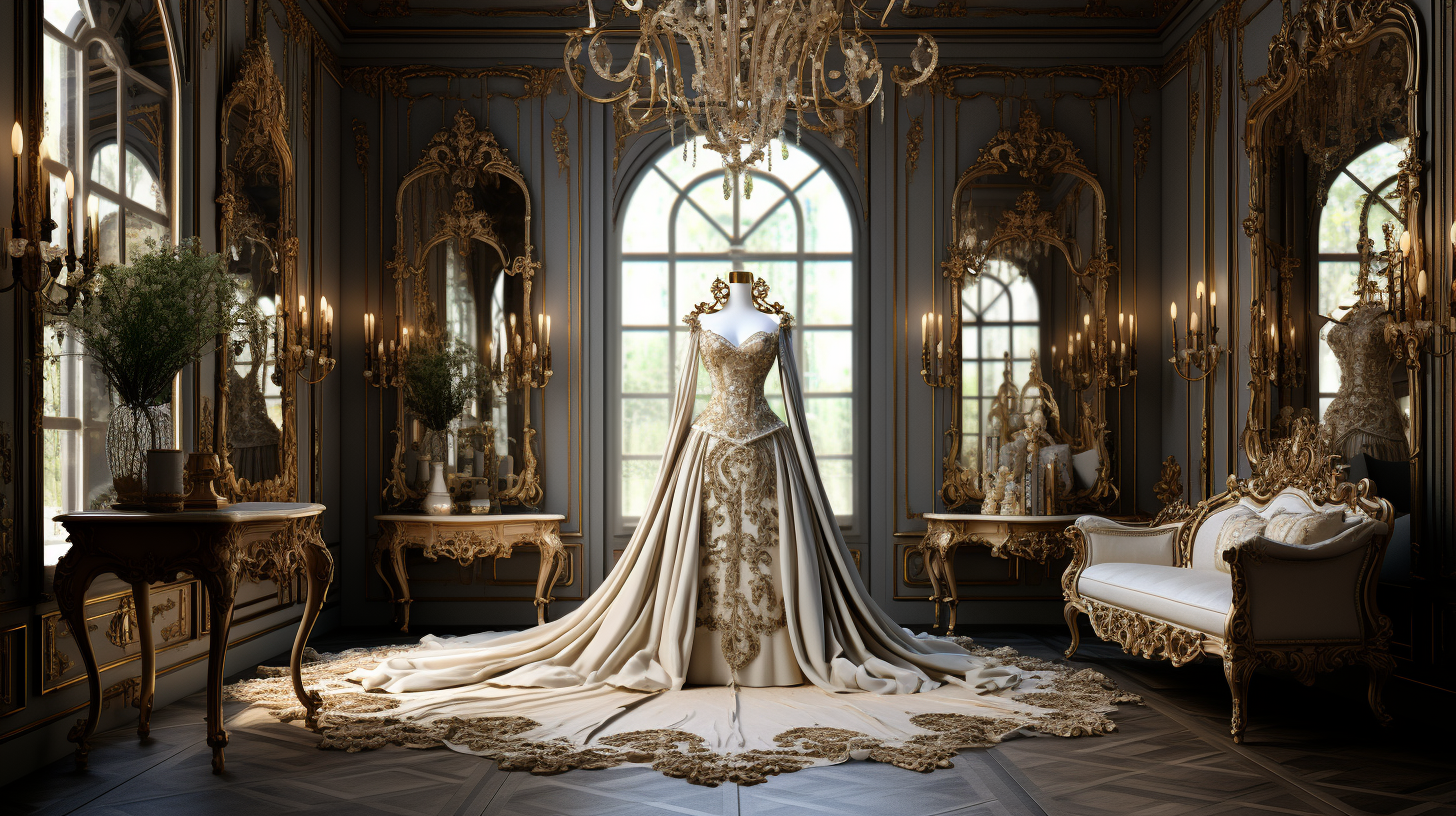

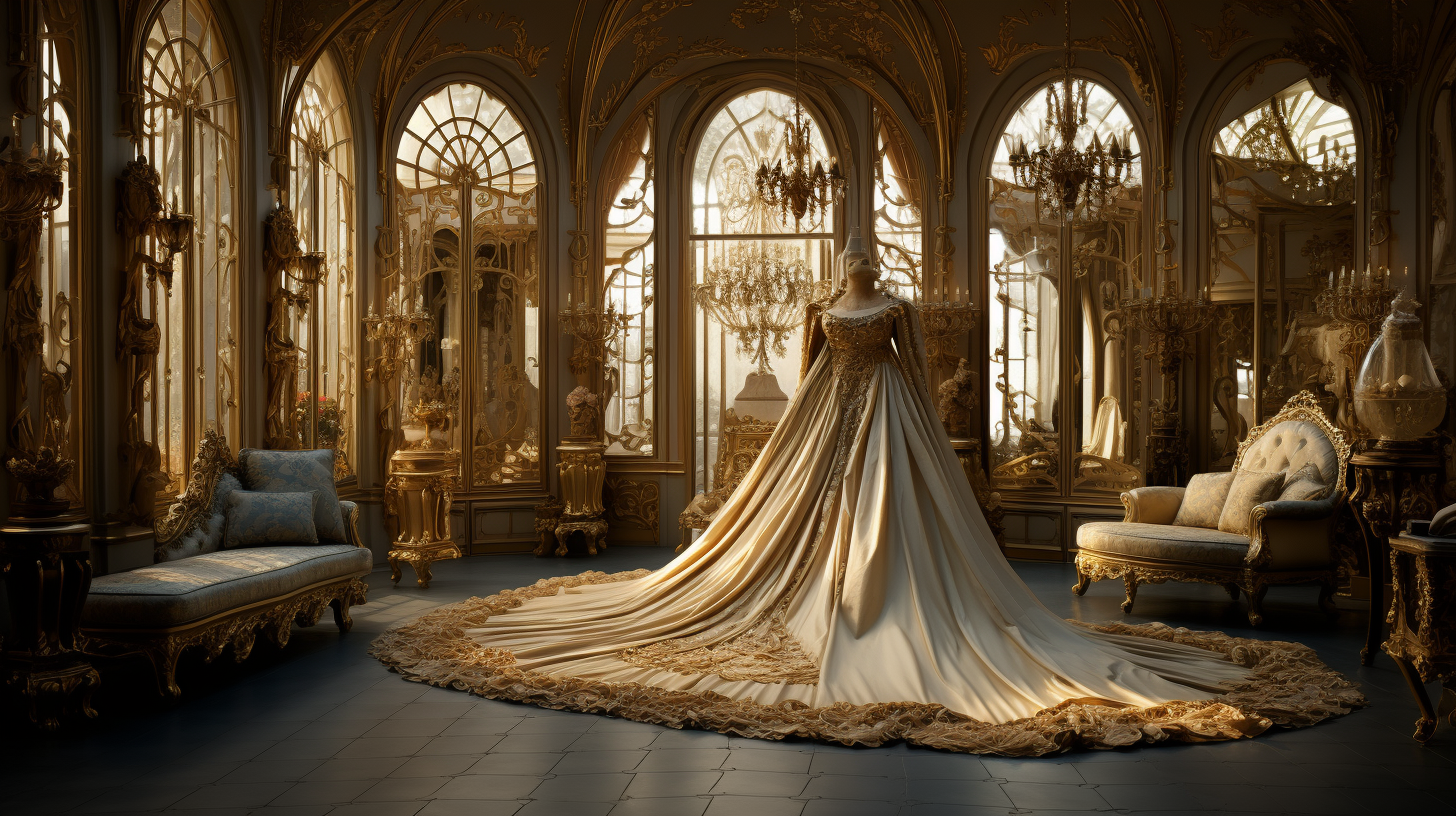
Image: an opulent drawing room adorned with golden accents and lush fabrics. In the center stands a mannequin draped in Baroque attire, complete with embroidered gowns and intricate accessories. On the wall behind it,
The Cultural Canvas: Setting the Stage for Baroque Fashion
Let us turn back the hands of time, walking the cobblestone streets of Europe as the 17th century dawns. What unfolds around us is nothing short of a cultural renaissance. The world is emerging from the Medieval ages, the stench of plague dissipating into a new world order. Kings and queens hold court in expansive palaces, their opulence mirrored in the arts, architecture, and of course, fashion. Baroque fashion was not born in isolation; it was the offspring of a society at the pinnacle of extravagance.
Power and Prestige
The fashion of this epoch was deeply rooted in the hierarchical structure that defined society. The materials one donned were not just an aesthetic choice but also a demonstration of social standing. Velvet, silk, and brocade were the domain of nobility, a sartorial demarcation as significant as the titles that preceded names.
Religion and Spirituality
The church had its fingers entwined deeply in the fabric of society, and this was reflected in the clothing of the time. Flowing gowns mimicked the opulence of religious vestments, and the use of gold thread in garments was a nod to the divine.
The Arts: Painting and Music
The flourishing arts scene also had a profound influence on fashion. Think of Vivaldi’s cascading notes or Caravaggio’s mastery of light and shadow. The same dramatic flair and intricate detail found their way into the gowns, waistcoats, and accessories of the Baroque period.
Societal Norms and Values
Much like a painting, every stitch and seam had its place, each contributing to a broader cultural narrative. It wasn’t just about looking good; it was about aligning oneself with the societal values of modesty, decorum, and moral righteousness, albeit wrapped in a grandiose package.
🎨 Image Description for Graphic Designer: Picture a lavish ballroom filled with people adorned in Baroque fashion. The room is dimly lit by chandeliers, and in the background, a painting depicts a religious scene, perhaps an angel or a saint, framed in intricate gold. In the foreground, focus on a woman’s gown detailing and a man’s embroidered waistcoat, capturing the essence of societal hierarchies, religious influence, and artistic splendor all in one image.
The Symphony of Fabrics: Silk, Velvet, and More
If you were to listen closely, each fabric used in Baroque fashion would sing a different tune, much like the instruments in a finely tuned orchestra. The garments of this era were not just sewn; they were composed, bringing together diverse textiles that each told a story of opulence and grandeur.
The Luxurious World of Silk
Silk was the soprano of the Baroque fabric orchestra, hitting the high notes with its shimmering surface and luxurious feel. Imported from the Far East, it was a symbol of wealth and exoticism. Silk garments often featured complex patterns and floral motifs, woven directly into the fabric or embroidered with skillful artistry.
Velvet’s Rich Harmony
Then there was velvet, a fabric that one might say is the alto of this ensemble. Its deep, soft texture was perfect for conveying a sense of power and gravitas. Frequently dyed in rich, saturated colors like royal blue or deep red, velvet was used in everything from waistcoats to gowns.
The Intricacy of Brocade
Let’s not forget the baritone in this Baroque symphony: brocade. A complex fabric with raised designs often made with colored silks and gold and silver threads, brocade gave outfits a texture that was visually striking and inviting to the touch.
Subtlety in Linen and Cotton
And finally, a moment for the tenors of the fabric world: linen and cotton. Less opulent than their counterparts, they were nonetheless essential for undergarments and lining. They allowed the wearer not just to show off wealth, but also to move with comfort and ease.
🍂 Image Description for Graphic Designer: Picture a swath of diverse fabrics fanned out like a palette of colors. Start from the left with shimmering silk in a vivid pattern, then move to a patch of lush, deep-colored velvet. Next to it, show an intricate brocade with gilded threads woven in. Finally, conclude with a simple yet finely woven piece of linen. It should capture the gamut of textiles that made Baroque fashion not just clothing, but wearable art.
Stitches and Stories: The Art of Baroque Tailoring
In the same way a painter has brushes and a writer has words, the tailors and seamstresses of the Baroque era had their stitches and patterns. This was not mere sewing; this was storytelling with needle and thread. With the turn of every seam, the completion of every stitch, and the adornment of every button, a narrative was woven—one of elegance, sophistication, and unmistakable Baroque fashion.
The Mastery of the Stitch
An exquisite garment in the Baroque period was not just the sum of its fabrics but also the mastery of its stitches. Consider the backstitch, strong and durable, ideal for seams that take on heavy stress. Then we had the running stitch, quick to execute but strong enough to hold. These were not mere methods of joining fabric; they were the sentence structure of a visual language, the grammar of grandeur.
Embroidery: A Language of its Own
Embroidery was akin to poetry in the realm of Baroque fashion. It was an art form that utilized colorful threads and sometimes even precious gems to form intricate designs. From botanical motifs to complex geometric shapes, embroidery was a skill highly valued and rigorously perfected.
The Role of Buttons and Fasteners
Even something as seemingly trivial as buttons played a significant role. Made from materials ranging from simple wood for the common folk to gilded metal and gemstones for the elite, buttons were both functional and decorative. Their placement and design could make or break a garment’s aesthetics.
The Human Touch: Hand versus Machine
Though the technology of the day could not rival our modern machinery, the absence of automated solutions meant that most garments were handmade, emphasizing the individual craftsmanship and devotion that each piece received. The hand-sewn quality lent an air of uniqueness, each stitch a fingerprint of the artisan.
🎨 Image Description for Graphic Designer: Imagine a vintage wooden table, atop which lie various tailoring tools: spools of colored threads, antique gold-plated scissors, a needle threaded with vibrant silk, and an in-progress embroidery hoop displaying a half-finished Baroque pattern. This table encapsulates the artistry and attention to detail that goes into Baroque tailoring.
Hues of Power: The Semiotics of Color in Baroque Fashion
Colors speak to us in ways words sometimes fail to capture. When used in clothing, they can convey messages, assert authority, and create emotional atmospheres. In Baroque fashion, the hues chosen were not merely to satisfy the eye, but also to express the social, political, and even religious landscapes of the times.
The Royal Spectrum: Red, Purple, and Gold
When one considers the color red in Baroque garments, one is reminded of power, of passion, and of the Church. This hue was especially favored by the clergy and nobility, often dyed using the cochineal insect to produce a rich and vibrant tone. Purple was equally esteemed, its rarity and cost associated with imperial power. Gold threads, sometimes actual strands of gold, were interwoven into fabrics or used in embroidery to elevate the garment to divine status.
Subtle Signals: Green, Blue, and Yellow
While not as ostentatious as red or gold, colors like green, blue, and yellow had their roles too. Green was often linked with youth and renewal, a nod perhaps to spring and its regenerative powers. Blue, especially darker shades, was a symbol of wisdom and stability. Yellow, surprisingly, had a dual role; it could signify both wealth and, less flatteringly, exclusion or treachery.
The Hidden Meanings of Neutrals: Black, White, and Brown
Neutral colors were not to be overlooked. White was seen as pure, often worn for weddings and other rites. Black, though we might associate it with mourning, was also a sign of affluence as quality black dyes were expensive and challenging to produce. Brown, the color of the earth, was the color of the common folk, practical and unpretentious.
🎨 Image Description for Graphic Designer: Imagine an elegantly designed color wheel set against an opulent Baroque background of intricate gold filigree. Each segment of the wheel features a fabric swatch that represents one of the Baroque era’s significant colors—red, purple, gold, green, blue, yellow, black, white, and brown. Around each swatch, tiny icons or motifs symbolize what that particular color traditionally represented in the Baroque era.
Threads of Splendor: The Fabrics that Wove Baroque Reality
Ah, the rich tapestry that is Baroque fashion would be but a mere sketch without the intricate fibers and textiles that lend it substance and shape. Like a symphony that requires various instruments to complete its harmonious melody, Baroque fashion needed a plethora of fabrics to manifest its grand vision.
Silk: The Fabric of Kings and Queens
When you touched a silk garment during the Baroque period, you were essentially caressing liquid gold. Silk was extraordinarily expensive to produce, requiring thousands of silkworms and specialized looms that were operated by the most skilled artisans. In fact, some varieties of silk were so precious that they were reserved strictly for the monarchs and the nobility.
Brocade and Velvet: Textured Opulence
Brocade and velvet offered a tactile experience unlike any other. Brocade, woven with elaborate designs often enhanced with gold or silver threads, was a favorite for festive garments and special occasions. Velvet, with its plush, fuzzy texture, was often dyed in rich, deep colors like burgundy or navy blue, offering a luxurious contrast to other fabrics.
Wool and Linen: The Unsung Heroes
While silk, brocade, and velvet stole the spotlight, wool and linen were the workhorses of the era. Wool was favored in colder climates and could be dyed in a multitude of hues, serving both functional and aesthetic purposes. Linen was breathable and ideal for undergarments and linings. It was the fabric of choice during the warmer months and served as a versatile base for layering other materials.
🎨 Image Description for Graphic Designer: Visualize a grand hall adorned with Baroque architectural details like ornate carvings and gilded moldings. On display are mannequins elegantly dressed in Baroque-era garments, each made from a different fabric—silk, brocade, velvet, wool, and linen. Each mannequin stands on a small pedestal with a placard that identifies the fabric and gives a brief history. The lighting casts a soft glow, accentuating the textures and colors of each garment.
Unveiling Opulence: The Accessorizing of Baroque Grandeur
To truly appreciate the splendor of Baroque fashion, we must shift our gaze from the main act to the supporting cast. Imagine attending a grand masquerade, your vision encased in gold-leaf filigree or delicate lace. Visualize a nobleman, his hands adorned with rings that signify wealth, power, and family lineage. Yes, the accessories of the Baroque era were far from mere afterthoughts; they were statements in themselves.
Ruffs and Lace Cuffs: Framing the Elite
🎭 Ruffs: The ruff, made of meticulously pleated linen, served as a frame for the face. Both men and women wore this detachable accessory that could range from modest and flat to extravagant and voluminous.
🎭 Lace Cuffs: These were an extension of the elegance that the ruff provided, only this time, framing the wrists. Often crafted from exquisite lace, these cuffs were yet another way to flaunt one’s status and style.
Jewelry: A Glimpse into Wealth and Power
💍 Rings: From signet rings etched with family crests to gem-encrusted pieces, rings were small but powerful markers of one’s standing.
💍 Necklaces and Pendants: Often intricately designed, these pieces were a celebration of craftsmanship, composed of everything from pearls to diamonds.
Footwear: Statures and Status
👠 Heeled Shoes: Elevated both literally and metaphorically, heels were a statement piece in Baroque fashion.
👠 Buckles and Embellishments: Often crafted from precious metals, shoe buckles were far more than functional; they were pieces of art that further accentuated the feet.
🎨 Image Description for Graphic Designer: Imagine a lavish Baroque boudoir, complete with intricate wallpaper, plush velvet cushions, and ornate mirrors. On a beautifully crafted table lies an assortment of Baroque accessories: ruffs, lace cuffs, a variety of rings, exquisite necklaces, and a pair of elegantly heeled shoes with ornate buckles. Each accessory is spotlighted to bring out its details, and an artistically designed label accompanies each item, describing its significance.
Threads of Majesty: The Hidden Messages in Baroque Embroidery
Much like a skilled composer employing an array of notes to construct a symphony, the artists of Baroque fashion used the needle and thread as their instruments. Yet this isn’t just about ornamentation; it’s about conversation. Yes, indeed. Embroidery in the Baroque era was an eloquent language all its own.
Intricacy as the Soul of Design
🧵 Stitches and Techniques: The craftsmanship in the Baroque period utilized a myriad of stitches such as cross-stitch, chain stitch, and satin stitch. The stitches were not just about form; they had function. Each stitch communicated something different, much like the words in a sentence.
🧵 Materials: Gold and silver threads often found their way into these intricate designs, adding an extra layer of richness and complexity to the already elaborate patterns.
Symbolism: Unspoken Statements
🕊 Floral Motifs: Flowers were not merely decorative; they had symbolic meanings. Roses signified love and passion, while lilies often symbolized purity.
🕊 Animal Imagery: Creatures like birds and lions were commonly embroidered into garments, each animal a symbol of particular virtues or characteristics.
Narratives in Thread
📖 Historical References: Battle scenes, Biblical stories, and mythological tales were sometimes depicted, serving both as art and as commentary.
📖 Personal Monograms: Personalized embroidery offered a form of self-expression and individualism within the broader cultural context.
🎨 Image Description for Graphic Designer: Envision an opulent Baroque tapestry displayed against a dark, velvet background. The tapestry features intricate embroidery in gold and silver threads. It includes floral motifs, animal imagery, and a center panel depicting a historical event. Floating labels annotate the various stitches and symbols, explaining their historical and cultural significance.
The Performance of Dress: Baroque Fashion as Theater
Step into the parlor, where fashion transcends mere fabric to become a dynamic act of theater. The Baroque stage extends beyond wooden floors and velvet curtains; it is woven into the very threads of the garments themselves.
The Anatomy of Elegance
🎭 Silhouettes: While embroidery conveyed language, the silhouette of a garment portrayed the mood. The women’s gowns were often heavy, voluminous, and ornate, with structural components like panniers providing an exaggerated hip width.
🎭 Colors and Dyes: Crimson, indigo, and other vivid colors were no mere aesthetic choices. These hues required complicated dyeing processes and rare ingredients, making them status symbols.
The Players: Role-Specific Attires
🎬 Royalty and Nobility: Kings and queens did not just wear clothes; they wore declarations. Elaborate trains, real fur trims, and intricate lacework conveyed the wearer’s royal status.
🎬 The Common Folk: The garments of everyday people were simpler but not without meaning. An apron might signify a woman’s marital status, while a cap could indicate a man’s profession.
Setting the Stage: Contextual Fashion
🌍 Seasonal and Occasional Variations: The season and occasion dictated the choice of fabrics. Linens and cottons were preferred in the summer, while heavy brocades and velvets warmed winter evenings.
🌍 Global Influences: The international trade routes of the Baroque period also played a role, as silks from Asia and lace from France became significant components in fashion.
🎨 Image Description for Graphic Designer: Imagine a lavish Baroque ballroom filled with people in intricate outfits. The focus is on three figures: a royal woman in an opulent gown with exaggerated hips, a nobleman in an embroidered coat, and a commoner in simpler, functional attire. Annotations should highlight the features like silhouettes, colors, and accessories that define their roles and statuses.
The Echoes of Grandeur: Baroque’s Legacy in Modern Fashion
As we tread lightly on the bridge between yesteryears and today, the footprints of the Baroque era seem ever so clear. This is not a conclusion but a revelation: the legacy of Baroque fashion endures in our modern couture.
Threads of Continuity
🔗 High Fashion and Couture: Designers today pay homage to the theatricality of the Baroque period through extravagant runway pieces. From Alexander McQueen’s heavily embellished gowns to John Galliano’s intricate embroidery, the essence of Baroque fashion echoes through haute couture.
🔗 Wedding Fashion: Many brides opt for gowns that speak the grandiose language of Baroque, with intricate lacework, exaggerated silhouettes, and layers upon layers of luxury fabrics.
🔗 Streetwear with a Touch of Baroque: Believe it or not, Baroque patterns are also making appearances in casual fashion. You’ll find elaborate designs on t-shirts, bomber jackets, and even sneakers.
Timeless Fabrics and Motifs
🎨 Lace and Brocade: The texture-rich fabrics like lace and brocade that were popular during the Baroque period still find their places in fashion houses and boutiques.
🎨 Patterns and Motifs: Fleur-de-lis, damasks, and intricate floral patterns have stood the test of time, appearing in everything from upholstery to evening wear.
Accessories That Speak Volumes
👑 Statement Jewelry: The love for opulence hasn’t dimmed. Chunky necklaces, grandiose tiaras, and ornate earrings continue to adorn us, taking direct inspiration from the Baroque’s love for accessorizing.
👑 Elaborate Footwear: Baroque’s imprint is evident in the form of decorative shoes with ornate buckles and embroidery, a trend still coveted in today’s fashion world.
🖼 Image Description for Graphic Designer: Envision a split screen, with one side showcasing a woman in a classic Baroque gown, and on the other, a modern bride or fashion model wearing a garment that is unmistakably influenced by the Baroque style. Highlight areas where the modern design has taken cues from the classic, such as the lacework, embroidery, or silhouette.
The journey may be over for now, but the rich details and sumptuous artistry of Baroque fashion continue to echo in the folds of today’s garments, in the twinkling of today’s jewels, and in the architecture of today’s grandest heels. 🥿👗💎
In reflecting on this opulent era, one cannot help but recognize that the Baroque’s resplendent tendrils reach not just into our closets, but into the very way we perceive grandeur and elegance. The Baroque period has never truly ended; it’s been reimagined, redefined, and will undoubtedly continue to reshape the future of fashion.
And so, as the sun dips below the horizon and the velvet sky rolls in, we bid adieu to this chapter but not to the story. For as long as humanity has a penchant for the magnificent, the spirit of the Baroque era will live on. 🌅🌌



